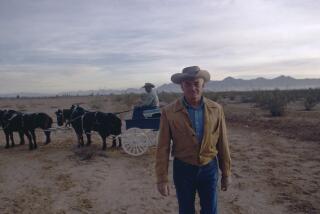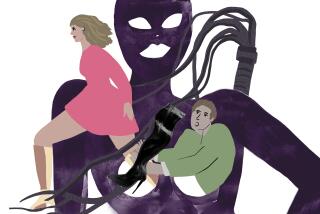Lassoing the Cowboy of Her Dreams
“DESPERATELY SEEKING buckaroo with slow hand, easy touch. Must be tall, taciturn, look good in chaps. Me: DJF, 49, two kids, professional writer (‘Loose Change,’ a bestselling account of ‘60s counterculture life; scripts for the TV drama ‘Dr. Quinn, Medicine Woman’), tired of the L.A. Weekly classified dating scene (producers with Porsches don’t do it for me anymore), in need of a good man to make me feel at home on the range. You: DWM willing to shuttle from Arizona line shack to Malibu for romantic interludes. Must have soft spot for horses, pickup trucks and overcomplicated urban women. Convince me that I’m not making a mistake by falling for a guy with much less money and education than I have. Better yet, convince my children, friends and co-workers.”
Sara Davidson didn’t actually run such an ad in 1993, when this fictionalized memoir begins, and, as it turns out, she didn’t need to. She met the man she calls Zack at a cowboy poetry festival in Elko, Nev. No versifier--in his first letter to her, “every third word is misspelled”--he was trying to sell bridles and other gear he had painstakingly braided of rawhide in 19th century fashion.
Much later, Zack revealed what his thoughts had been when he saw the 5-foot-10 Davidson, with her Calvin Klein jeans and Italian shoe-boots and “piercing” reporter’s eyes, braless under her teal-blue shirt, approach him in a festival dance hall: “Trouble on the hoof. Keep your head down, maybe she won’t see you.”
Davidson, for her part, says she had always liked the cowboy image of “ruggedness and wildness, cockiness, a sense of fun and an intimate power over animals,” but believed that any individual ranch hand--even one with Zack’s mannerliness and green-eyed good looks--would “possess a crude, right-wing dumbness, so that for a woman with a certain education, a romance with a cowboy would be a misalliance.”
They are, truly, people from two different worlds. Zack smokes. He dismisses Italian food as “foreign.” He has never heard of “King Lear” or the Holocaust. He’s a wham-bam lover until Davidson teaches him otherwise--after which, she reports with the satisfaction of one who has cleaned a stable and actually found that proverbial pony--”he seized the information I’d given him and ran with it . . . discovering zones and inventing variations I had not dreamed of. And I’ve been around the pool.”
Establishing a personal rapport is hard enough. Even more difficult is integrating Zack and Davidson into each other’s families, careers and financial expectations--though it’s an effort, she says, that succeeded: “The affair had a future that is now the present, and it has taught me things I did not know about love, the body and the heart, the way we link ourselves to people who may not be politically or socially or in any way correct.”
We learn a good deal about Davidson in “Cowboy.” Although she says she invented substitutes for her children, ex-husband and housekeeper, the substitutes are vividly drawn. She amusingly describes life on the set of “Dr. Quinn,” where she got Zack a job and the Hollywood wranglers resented him.
The glimpses we get of Zack, however, never quite cohere. A cowboy is “a blue-collar laborer who works long hours for low wages and no benefits,” Davidson tells us, but Zack is an engineer’s son who adopted the cowboy life for the “passion” of it, a former second-in-command at a feedlot who had 60 men working for him before his best friend stole his job and his wife, an artist in rawhide who is at least as committed to his aesthetic as Davidson is to hers. He is good with Davidson’s children and his own disabled son but confesses to disciplining kids in the past by grabbing their throats and choking them.
Throughout the book, we keep wondering, “What does he think about this stuff?” And we find out only now and then, in bits of dialogue that may or may not be true but have the feel of authenticity.
The day before his first flight to L.A., for example, Zack phones Davidson. He wants to know, he says warily, “Is this research?”
“You?”
“Yes, ma’am.”
“No, sir.”
“Thank you. I had to ask.”
More to Read
Sign up for The Wild
We’ll help you find the best places to hike, bike and run, as well as the perfect silent spots for meditation and yoga.
You may occasionally receive promotional content from the Los Angeles Times.






